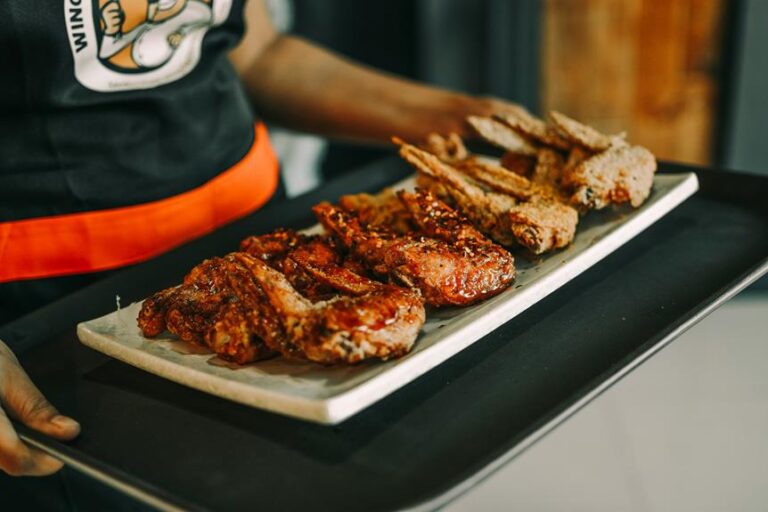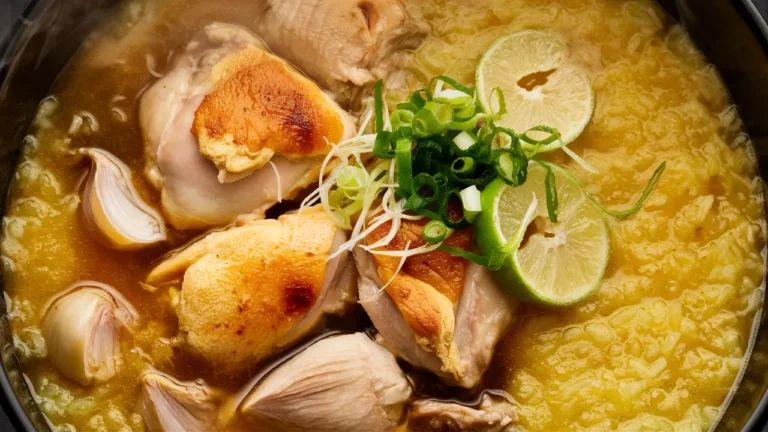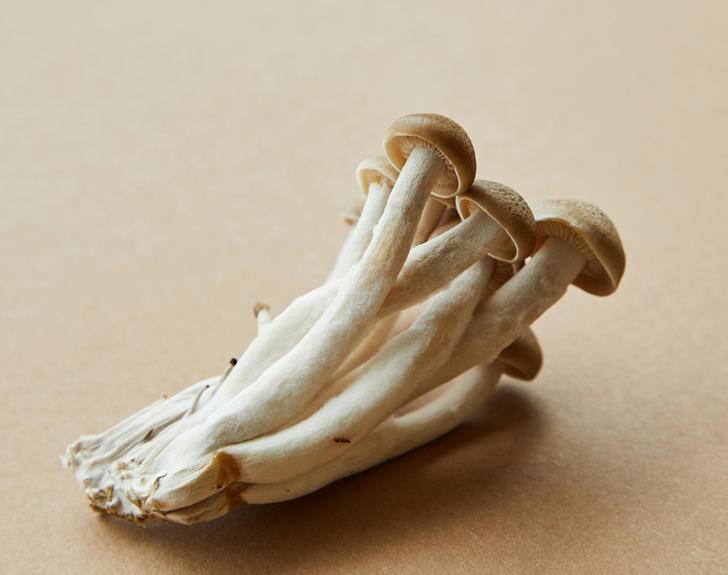Lechon: Unveiling the Secrets Behind the Philippines' Most Iconic Dish

You’re about to discover why lechon is the Philippines’ most iconic dish. Its origins date back to pre-colonial times, evolving through Spanish, Chinese, and American influences. Lechon’s distinct flavour comes from essential ingredients like lemongrass, garlic, and bay leaves, combined using traditional methods such as brining, flavour injection, and slow-roasting.
Each region of the Philippines has its unique take, from Cebu’s crispy skin to Mindanao’s succulent, spice-infused meat. More than just a dish, lechon is a symbol of abundance, unity, and Filipino heritage, making it a must-have at celebrations and gatherings. Continue to uncover the layers behind this culinary masterpiece.
Key Takeaways
- Lechon’s preparation includes brining and slow-roasting, ensuring juicy meat and crispy skin.
- Essential ingredients: whole pig, salt, peppercorn, lemongrass, and traditional Filipino spices.
- Regional variations like Cebu’s crispy skin and Mindanao’s tender meat showcase diverse culinary influences.
- Lechon symbolizes communal unity, celebration, and rich historical heritage in Filipino culture.
- Modern cooking techniques like sous vide and air frying maintain traditional flavours with contemporary methods.
Historical Origins
The historical origins of lechon are deeply intertwined with the Philippines’ colonial past, reflecting a rich fabric of cultural influences and culinary evolution.
You’ll find that lechon, a whole roasted pig, is more than just a dish—it’s a symbol of Filipino heritage shaped by centuries of trade, conquest, and adaptation.
The origins of lechon can be traced back to pre-colonial times when indigenous Filipinos practised spit-roasting. However, it was under Spanish colonization that the dish evolved significantly.
The Spanish introduced new techniques and flavors, integrating European culinary traditions with local ingredients. This period marked the fusion of native cooking practices with Spanish culinary artistry, giving birth to the lechon we’re familiar with today.
As time progressed, lechon’s evolution continued, incorporating Chinese and American influences brought by subsequent waves of migration and occupation. These interactions further diversified the dish, enriching its flavour profile and cooking methods.
Lechon became an integral part of Filipino celebrations, symbolizing abundance and community.
Understanding lechon’s historical context reveals its cultural significance. It’s not merely a roasted pig; it’s a narrative of the Philippines’ resilience and adaptability.
| Aspect | Details |
|---|---|
| Definition | A whole roasted pig dish popular in the Philippines and other parts of Southeast Asia |
| Origin | Philippines, with influences from Spanish cuisine |
| Main ingredient | Whole pig |
| Preparation method | Spit-roasted over charcoal for several hours |
| Seasoning | Typically includes salt, pepper, garlic, and lemongrass |
| Skin | Crispy and golden-brown, considered a delicacy |
| Occasions | Often served at festivals, holidays, and special events |
| Regional variations | Cebu lechon (seasoned with herbs and spices), Luzon lechon (stuffed with aromatics) |
| Serving | Usually carved and served with liver sauce or vinegar dip |
| Cultural significance | Symbol of Filipino hospitality and festivity |
Ingredients and Spices
You’re about to discover the essential ingredients and traditional Filipino spices that make lechon a cultural treasure.
Historically, each region has its unique blend of spices, reflecting local tastes and agricultural bounty.
These flavour-enhancing techniques not only preserve the dish’s authenticity but also elevate its status as a symbol of Filipino hospitality and celebration.
Essential Lechon Ingredients
Understanding the vital elements and spices used in lechon offers a glimpse into the rich mosaic of Filipino culinary heritage. The magic behind the succulent and crispy lechon lies in its meticulous preparation and diverse cooking techniques. Each ingredient contributes to its distinct taste, reminiscent of time-honoured traditions and cultural nuances.
To truly appreciate lechon, you need to know its core components:
- Whole Pig: The star of the show, chosen for its size and quality. The selection of the pig is pivotal as it affects the lechon’s texture and flavour.
- Salt: This fundamental seasoning enhances the meat’s natural flavours and helps achieve that desirable crispy skin.
- Peppercorn: Offering a subtle heat, peppercorns are often used to balance the rich, fatty taste of the pork.
- Lemongrass: Essential for stuffing the pig’s cavity, it imparts a unique, fragrant aroma that elevates the entire dish.
These ingredients are combined using various lechon preparation and cooking techniques, such as marinating, slow-roasting, and continuous basting. Each step reflects a deep-rooted history and cultural significance, ensuring that every bite of lechon is a tribute to Filipino culinary artistry.
Traditional Filipino Spices
When delving into traditional Filipino spices, you’ll uncover a treasure trove of ingredients that reflect the archipelago’s rich history and diverse cultural influences. These spices aren’t just about adding heat; they bring unique flavors that define Filipino cooking traditions.
The use of native ingredients such as calamansi, a small citrus fruit, and pandan leaves imparts a distinct aroma and tanginess that sets Filipino cuisine apart.
Historically, the Philippines has been a melting pot of cultures due to trade and colonization, which is evident in its spices. Spanish, Chinese, and indigenous influences converge in dishes like lechon, where spices like garlic, lemongrass, and bay leaves are essential.
The introduction of soy sauce and fish sauce from Chinese traders has also left an indelible mark on Filipino gastronomy.
Culturally, these spices are more than just ingredients; they’re woven into the fabric of Filipino identity. The meticulous preparation and choice of spices in lechon underscore a deep respect for culinary heritage and communal gatherings.
Flavor Enhancing Techniques
Building on the rich mosaic of traditional Filipino spices, mastering flavour-enhancing techniques is crucial in creating the iconic, mouth-watering experience that lechon is known for. The secret lies not just in the ingredients but in how you use them.
Here’s a closer look at the techniques:
- Brining Process: This step ensures that the meat remains juicy and flavorful. A mixture of water, salt, sugar, and spices like garlic and bay leaves penetrates the meat, enriching its taste from the inside out.
- Smoking Method: Traditional lechon often incorporates smoking, adding a deep, smoky flavor that complements the spices. The slow-smoking process also tenderizes the meat, making it succulent.
- Seasoning Options: Classic Filipino seasonings like lemongrass, garlic, and onions are stuffed into the pig, imbuing it with aromatic flavours. Some regions add their twist with local herbs and spices, creating distinctive regional variations.
- Basting Techniques: Basting the lechon with a combination of soy sauce, vinegar, and calamansi juice during roasting helps to develop a crispy, golden-brown skin while adding layers of flavor.
Preparation Techniques
To master the art of preparing lechon, one must explore the historical and cultural intricacies that define this beloved Filipino dish. The preparation techniques aren’t just about following recipes; they’re about understanding centuries-old traditions.
Historically, Filipinos have used a brining method to guarantee the meat remains succulent. This involves soaking the pig in a salt solution, which not only preserves it but also infuses it with flavor. Complementing this, a flavor injection of herbs and spices is often administered, reaching deep into the meat to guarantee every bite is rich and aromatic.
Culturally, the preparation of lechon is a communal activity, symbolizing unity and celebration. The process of slow cooking over an open fire is more than mere technique; it represents a ritualistic patience and dedication.
Charcoal roasting, a method passed down through generations, allows for even cooking and imparts a smoky essence that’s quintessential to authentic lechon. This method isn’t just practical but also deeply rooted in Filipino heritage, reflecting a connection to the land and its resources.
Cooking Methods
You’ll find that the traditional spit-roasting technique, a method passed down through generations, holds cultural significance and imparts unique flavours to lechon.
While modern oven methods offer convenience, they can’t replicate the authenticity of open-fire cooking. Secret marinade ingredients, often closely guarded family recipes, are essential in elevating the dish’s intricate taste profile.
Traditional Spit-Roasting Technique
Mastering the traditional spit-roasting technique of lechon requires an intricate understanding of its historical origins and cultural significance in Filipino festivities. This respected method isn’t just about cooking; it’s an art form that unites communities and pays respect to centuries of tradition.
To achieve an authentic encounter, you need to explore the seasoning secrets and time-honoured methods that make lechon a delectable masterpiece.
Here are the essential steps to envisage the process:
- Preparation: Carefully clean and marinate the pig, often with a mixture of garlic, lemongrass, and other spices. These seasoning secrets are essential for infusing rich, flavorful tastes.
- Spit-Roasting: Skewer the pig on a substantial bamboo pole. The slow rotation over an open flame ensures uniform cooking, giving the skin its distinctive, crunchy texture.
- Basting: Regularly baste the pig with a blend of oil and its juices. This step enhances the skin’s crunchiness and seals in moisture.
- Presentation: Once cooked, the lechon is typically showcased whole, symbolizing abundance and celebration, and carved in front of guests for an authentic encounter.
These cooking suggestions and tasty variations are crucial to perfecting lechon, mirroring its historical and cultural importance in the Philippines.
Modern Oven Methods
While traditional spit-roasting remains a revered method for preparing lechon, modern oven techniques offer a convenient alternative that maintains the dish’s iconic flavours and textures. With the advent of technology and changing lifestyles, many have turned to methods like sous vide and air frying to achieve that perfect lechon.
Sous vide, a method that involves cooking the meat in a vacuum-sealed bag submerged in water at a precise temperature, guarantees the meat is cooked evenly and retains its moisture. This technique allows you to infuse flavors deeply into the meat, mimicking the slow, deliberate cooking process of traditional spit-roasting. After sous vide, a quick blast in a hot oven crisps the skin to perfection.
Air frying, on the other hand, has gained popularity for its ability to produce a crispy lechon skin without the need for excessive oil. By circulating hot air around the meat, air fryers can replicate the crunchy exterior that’s a hallmark of lechon, while keeping the inside juicy and tender.
Secret Marinade Ingredients
Delving into the secret marinade ingredients of lechon reveals not just the essence of its enticing flavours but also a rich tapestry of Filipino cultural heritage and culinary wisdom. These marinades are carefully crafted to enhance the pork’s natural taste and infuse it with a symphony of flavors.
Here are four key ingredients that are often part of these flavorful combinations:
- Soy Sauce and Vinegar: This classic duo forms the base of many Filipino marinades, providing a balance of salty and tangy notes that penetrate deeply into the meat.
- Garlic and Lemongrass: Aromatic and pungent, these ingredients are essential for adding layers of complexity. Garlic offers a robust flavor, while lemongrass lends a citrusy, fragrant touch.
- Bay Leaves and Peppercorns: Often overlooked, these elements provide subtle yet vital taste enhancements. Bay leaves add a hint of bitterness, and peppercorns contribute a mild heat.
- Sugar or Honey: A touch of sweetness balances the savory and acidic components, ensuring a well-rounded flavor profile.
Understanding these cooking secrets illuminates the meticulous care and tradition embedded in preparing lechon. Each seasoning tip passed down through generations reflects the Filipino commitment to culinary excellence and communal celebration.
Regional Variations
Exploring the regional variations of lechon unveils not just culinary differences, but also the rich mosaic of cultural and historical influences across the Philippines. Each region offers unique twists and regional preferences that make their lechon distinct.
In Cebu, known for its crispy skin, the seasoning choices include a blend of lemongrass, garlic, and green onions, giving it a flavorful and aromatic profile. The Visayan style, on the other hand, is celebrated for its balance of flavors, often incorporating tanglad (lemongrass) and native spices that create a delightful experience.
Regional preferences also extend to cooking styles. In Luzon, for instance, you’ll find that lechon is typically roasted over charcoal, which imparts a smoky flavor that’s both robust and deeply enjoyable. Meanwhile, in Mindanao, some communities prefer a slow-cooked method, ensuring the meat is tender and infused with a variety of local spices. This method reflects the region’s historical trade connections and diverse cultural influences, integrating flavors from neighbouring countries.
Cultural Significance
Lechon’s cultural significance in the Philippines extends beyond its tantalizing flavors, symbolizing communal unity, celebration, and the nation’s rich historical heritage. When you think about lechon, it’s not just about a roasted pig; it’s about the moments and meanings that come with it.
This dish has a storied past that intertwines with the country’s history and traditions, making it much more than just food.
- Festive celebrations: Lechon is the centrepiece of major events such as fiestas, weddings, and Christmas. Its presence signifies abundance and joy, making every gathering special.
- Family gatherings: The process of preparing lechon is often a communal effort, involving several family members. This fosters a sense of togetherness and shared purpose, reinforcing familial bonds.
- Culinary heritage: Passed down through generations, the art of making lechon showcases the Philippines’ rich culinary traditions. Each region adds its twist, reflecting local tastes and methods.
- National pride: Lechon isn’t just a dish but a symbol of Filipino identity. Serving it at international events or to foreign guests is a matter of pride, showcasing the nation’s culinary excellence.
Interesting Facts About Lechon
- 🐷 Lechon is believed to have originated from the Spanish colonization of the Philippines, introduced in the 16th century.
- 🌴 In some parts of the Philippines, coconut water is used to baste the pig during roasting, adding a subtle sweetness to the meat.
- 🍽️ The crispy skin of lechon, known as “balat,” is so popular that some restaurants offer it as a separate dish.
- 🇵🇭 In Cebu, Philippines, Lechon is often stuffed with lemongrass, garlic, and green onions, giving it a distinct aromatic flavour.
- 🎉 Lechon is considered a status symbol in Filipino culture, often served at important celebrations and gatherings.
- 🥄 The traditional way to eat lechon is with your hands, tearing off pieces of meat and skin.
- 🌿 In some regions, the pig is rubbed with native herbs like tanglad (lemongrass) and sambong leaves before roasting.
- 🇵🇷 Puerto Rican lechon is often marinated in a mixture of garlic, oregano, and vinegar before roasting.
- 🔥 The roasting process for a whole pig can take up to 6 hours, depending on the size of the animal.
- 🏆 In 2018, lechon was named the “Best Pork Dish in the World” by Time Magazine’s food critic.
Frequently Asked Questions
How Can Leftover Lechon Be Stored and Reheated?
For freezing leftovers, wrap lechon tightly to guarantee long-term storage and food safety. Reheating methods include oven or stovetop for maintaining texture. Historically, preserving lechon reflects cultural significance in maximizing festive dishes’ longevity.
Are There Any Health Benefits to Eating Lechon?
You might enjoy lechon for its rich flavour, but be aware of its nutritional benefits and impact on cholesterol levels. Historically, it’s been a cultural staple, yet moderation is key due to potential health risks.
What Beverages Pair Well With Lechon?
For wine pairings, try a light red or crisp white. Beer options like pale ales work well. Cocktail suggestions include mojitos. Non-alcoholic alternatives like coconut water or iced tea offer cultural significance, balancing lechon’s rich flavours.
How Do You Carve Lechon for Serving?
When carving lechon, use precise knife techniques to enhance the presentation. Start with the belly for tender meat. This process is steeped in cultural traditions, often performed during special occasions, reflecting the dish’s historical and cultural significance.
Can Lechon Be Made Using Alternative Meats?
Yes, you can make lechon using alternative meats like duck lechon or lamb lechon. Historically, Filipinos have adapted recipes to suit available resources, reflecting the cultural significance and versatility of this iconic dish.
Conclusion
In understanding lechon’s historical roots, intricate preparation, and regional nuances, you’ve uncovered more than just a dish; it’s a cultural emblem.
Each bite connects you to centuries-old traditions, diverse culinary practices, and the communal spirit of Filipino celebrations. By relishing lechon, you’re not just indulging in its flavors but also appreciating its rich history and cultural significance. This iconic dish is a tribute to the Philippines’ vibrant heritage and culinary ingenuity.






